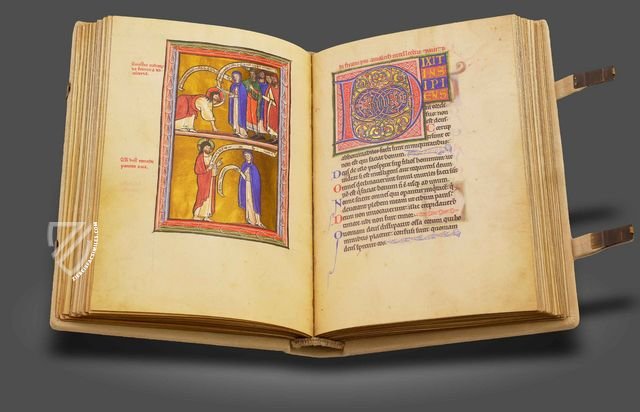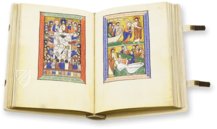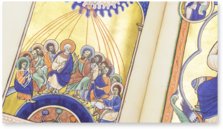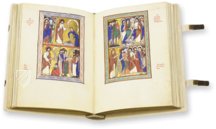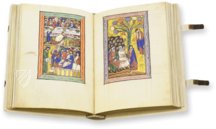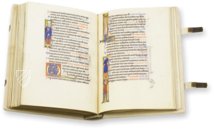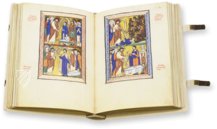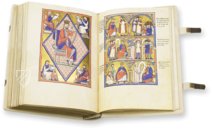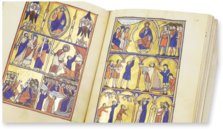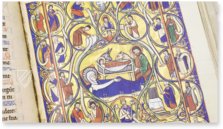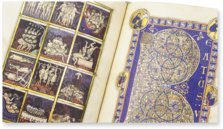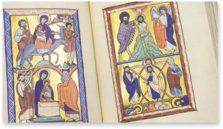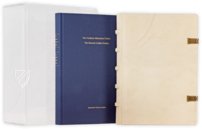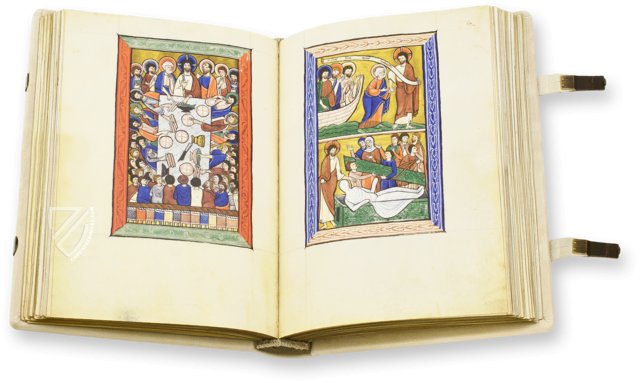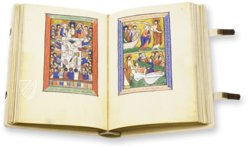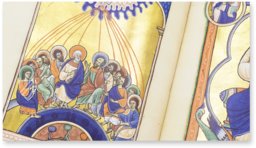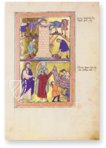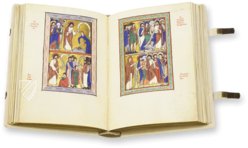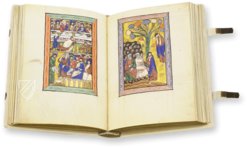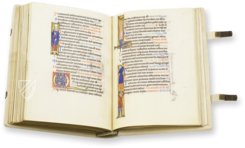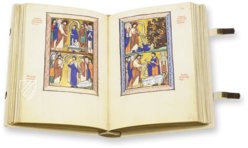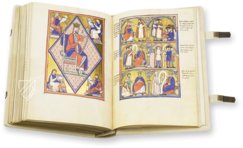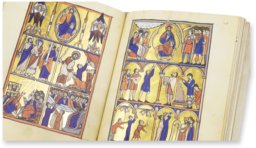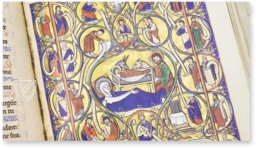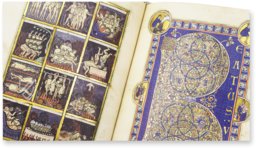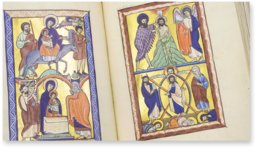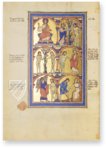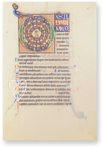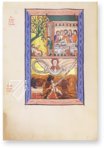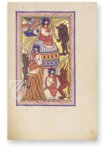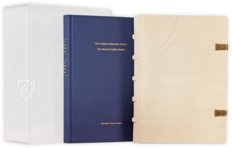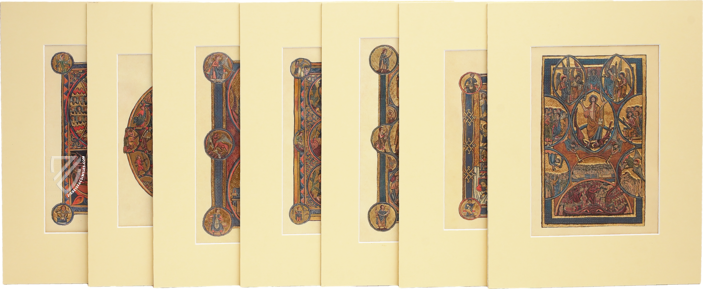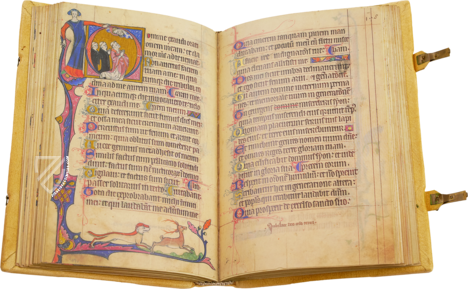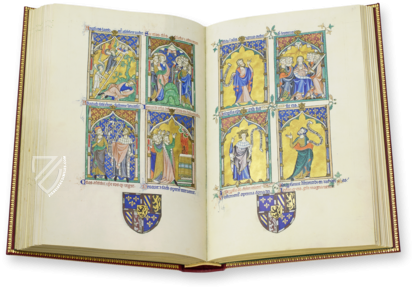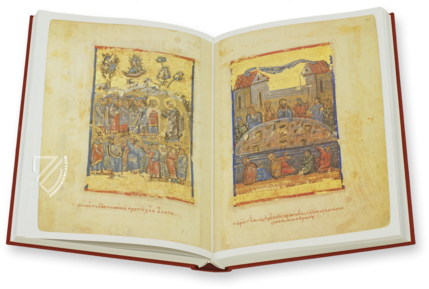Munich Golden Psalter
(3,000€ - 7,000€)
The Munich Golden Psalter was created at the beginning of the 13th century, presumably by three Oxford illuminators. This exceptionally richly illustrated and decorated codex contains numerous miniatures against a gold background, golden written elements, and costly gold initials, as well as countless other decorative elements. The Munich Psalter is especially famous for its unusual new style of illumination, which marks the transition from the Romanesque to the Gothic style. Its elaborate image program consists of 91 full-page miniatures with gold backgrounds, 24 calendar medallions, and 10 large historiated initials as well as decorative red and blue lines, animals, human heads, and hybrid creatures integrated into the text. As such, the richly illuminated manuscript is considered to be the most precious Psalter to have ever been created.
Munich Golden Psalter
At the end of the 12th century, private devotional books became increasingly popular with the educated upper crust of society. The demand for psalters was especially great. These were collections of Psalms, which were used daily in mass. Among the numerous psalters of this time, at the beginning of the 13th century, the Munich Golden Psalter is presumed to have been created by three masters from Oxford. This work is considered to be the most valuable Psalter to have been made in any epoch due to its exceptionally rich book decoration and its innovative artistic expression. The opulent codex contains 166 pages with 91 full-page miniatures with gold backgrounds, 24 calendar medallions, colorful and gold-decorated initial pictures, as well as colorful trimmed lines on every page. Today this magnificent manuscript is located in the Munich City Library.
A Book Trend of the Middle Ages
As a rule, a psalter contains 150 prayers and hymns, which do not tell any kind of cohesive story but consisted of glorifications of God, entreaties, grievances, and thanks instead. Even today the Psalms are considered to be one of the most important parts of Christian and Jewish liturgy. In the Middle Ages the demand for these easily understandable texts was rapidly rising. These works enjoyed an especially great popularity in England and northern France. The most gifted and well-versed illuminators of this genre came mostly from England. It is presumed that the masters who created the Munich Golden Psalter were three artists from Oxford.
Exceptionally Diverse Book Decoration
In the majority of psalter handbooks the miniatures and picture cycles of the Old and New Testaments are concentrated at the beginning of the work. However, the Munich Golden Psalter was arranged differently. The codex begins with 24 impressive calendar medallions, which are followed by 27 full-page miniatures of Genesis, the story of Joseph, the flight from Egypt, and up to the fall of Jericho. Finally, 19 pictures of the New Testament thematized the life of Jesus Christ. This cycle ends with depictions of Judgement Day and the torments of hell. This is followed by miniatures that show the various miracles of Jesus, stories from the Old Testament books, Ruth, Judith, and Esther are pictorially depicted, as is the life of King David. David is considered to be the creator, which is to say the author, of a large number of the Psalms. No other Psalter has anywhere near such a wealth of pictures.
New Form of Expression and Ornamentation
The Psalms of the Munich Golden Psalter were decorated in unbounded fantasy with whole page golden figural initials, half page miniature-like initials, multicolored bows and ribbons, and intertwined tendrils. The time of the work’s creation between 1180 and 1220 is considered to be the transitional style of English book painting. Artists at the end of the Romanesque era sought new forms of pictorial expression, but were still somewhat removed from Gothic illumination. Depictions of figures were less expressive. Human bodies were still not precisely portrayed, however attention was now paid to more correct and less exaggerated proportions and posture. Meticulously modeled faces, flowing garments, shading, and color gradiation characterize the pictures of the Munich Psalter. All of these endeavors by the artists point the way to a new, more natural style of book painting.
Codicology
- Alternative Titles
- Der Goldene Münchner Psalter
Goldener Münchner Spalter
Psautier doré de Munich - Size / Format
- 332 pages / 28.0 × 19.5 cm
- Origin
- United Kingdom
- Date
- 1200–1210
- Epochs
- Style
- Genre
- Language
- Illustrations
- 91 full-page miniatures, 24 calender medallion miniatures, and 10 large historiated initials
- Artist / School
- Three masters from a workshop in Oxford
- Previous Owners
- Duke Maximilian I of Bavaria (1573–1651)
Munich Golden Psalter
Historiated “O” Initial
Historiated initials are a prominent feature of Romanesque manuscripts with artists devoting as much energy to their creation as they did to the miniatures. This “O” initial is filled with white lions that run around a mythical creature playing the harp. A drollery with the body of a peacock holds the severed head of a bearded man in its mouth in the upper left corner. This historiated initial is a kaleidoscope of colors and gold leaf with a diamond-patterned background and winding tendrils.
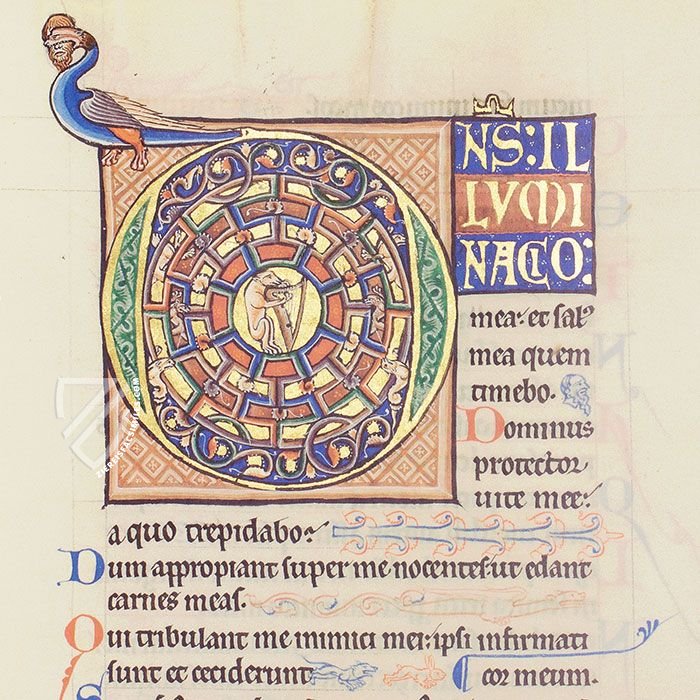
Munich Golden Psalter
The Temptation of Christ
After his baptism by John the Baptist, Jesus went to the Judean Desert to fast for 40 days and nights, during which time he was tempted by Satan. This innovative miniature depicts this series of events in a single image contained within a lovely frame of delicate pink and night blue.
The timeless and spaceless effect of the burnished gold background allows the narrative to travel across the page. Starting at the bottom, Satan tempts Jesus by offering to turn stones into bread. Moving up and to the left, we see the temptation on the mountain, where Satan offers Jesus dominion over all earthly kingdoms. The final image at the top shows the temptation on the pinnacle of the temple, resisting Satan once again before being ministered to by angels.
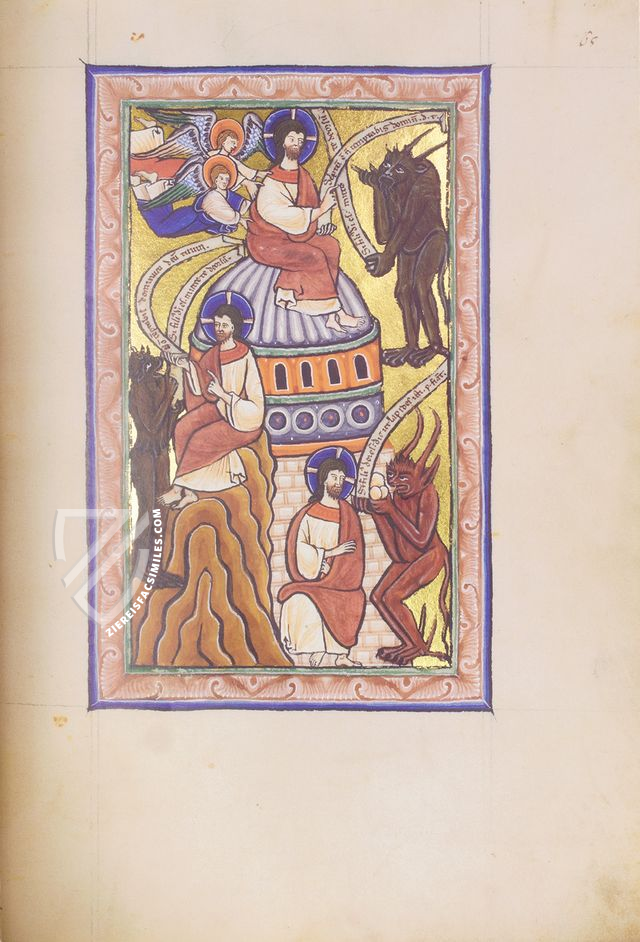
#1 Der Goldene Münchner Psalter
Languages: English, German
(3,000€ - 7,000€)
- Treatises / Secular Books
- Apocalypses / Beatus
- Astronomy / Astrology
- Bestiaries
- Bibles / Gospels
- Chronicles / History / Law
- Geography / Maps
- Saints' Lives
- Islam / Oriental
- Judaism / Hebrew
- Single Leaf Collections
- Leonardo da Vinci
- Literature / Poetry
- Liturgical Manuscripts
- Medicine / Botany / Alchemy
- Music
- Mythology / Prophecies
- Psalters
- Other Religious Books
- Games / Hunting
- Private Devotion Books
- Other Genres
- Afghanistan
- Armenia
- Austria
- Belgium
- Belize
- Bosnia and Herzegovina
- China
- Colombia
- Costa Rica
- Croatia
- Cyprus
- Czech Republic
- Denmark
- Egypt
- El Salvador
- Ethiopia
- France
- Germany
- Greece
- Guatemala
- Honduras
- Hungary
- India
- Iran
- Iraq
- Israel
- Italy
- Japan
- Jordan
- Kazakhstan
- Kyrgyzstan
- Lebanon
- Liechtenstein
- Luxembourg
- Mexico
- Morocco
- Netherlands
- Palestine
- Panama
- Peru
- Poland
- Portugal
- Romania
- Russia
- Serbia
- Spain
- Sri Lanka
- Sweden
- Switzerland
- Syria
- Tajikistan
- Turkey
- Turkmenistan
- Ukraine
- United Kingdom
- United States
- Uzbekistan
- Vatican City
- A. Oosthoek, van Holkema & Warendorf
- Aboca Museum
- Ajuntament de Valencia
- Akademie Verlag
- Akademische Druck- u. Verlagsanstalt (ADEVA)
- Aldo Ausilio Editore - Bottega d’Erasmo
- Alecto Historical Editions
- Alkuin Verlag
- Almqvist & Wiksell
- Amilcare Pizzi
- Andreas & Andreas Verlagsbuchhandlung
- Archa 90
- Archiv Verlag
- Archivi Edizioni
- Arnold Verlag
- ARS
- Ars Magna
- ArtCodex
- AyN Ediciones
- Azimuth Editions
- Badenia Verlag
- Bärenreiter-Verlag
- Belser Verlag
- Belser Verlag / WK Wertkontor
- Benziger Verlag
- Bernardinum Wydawnictwo
- BiblioGemma
- Biblioteca Apostolica Vaticana (Vaticanstadt, Vaticanstadt)
- Bibliotheca Palatina Faksimile Verlag
- Bibliotheca Rara
- Boydell & Brewer
- Bramante Edizioni
- Bredius Genootschap
- Brepols Publishers
- British Library
- C. Weckesser
- Caixa Catalunya
- Canesi
- CAPSA, Ars Scriptoria
- Caratzas Brothers, Publishers
- Carus Verlag
- Casamassima Libri
- Centrum Cartographie Verlag GmbH
- Chavane Verlag
- Christian Brandstätter Verlag
- Circulo Cientifico
- Club Bibliófilo Versol
- Club du Livre
- CM Editores
- Collegium Graphicum
- Collezione Apocrifa Da Vinci
- Comissão Nacional para as Comemorações dos Descobrimentos Portugueses
- Coron Verlag
- Corvina
- CTHS
- D. S. Brewer
- Damon
- De Agostini/UTET
- De Nederlandsche Boekhandel
- De Schutter
- Deuschle & Stemmle
- Deutscher Verlag für Kunstwissenschaft
- DIAMM
- Droz
- E. Schreiber Graphische Kunstanstalten
- Ediciones Boreal
- Ediciones Grial
- Ediclube
- Edições Inapa
- Edilan
- Editalia
- Edition Deuschle
- Edition Georg Popp
- Edition Leipzig
- Edition Libri Illustri
- Editiones Reales Sitios S. L.
- Éditions de l'Oiseau Lyre
- Editions Medicina Rara
- Editorial Casariego
- Editorial Mintzoa
- Editrice Antenore
- Editrice Velar
- Edizioni Edison
- Egeria, S.L.
- Eikon Editores
- Electa
- Emery Walker Limited
- Enciclopèdia Catalana
- Eos-Verlag
- Ephesus Publishing
- Ernst Battenberg
- Eugrammia Press
- Extraordinary Editions
- Fackelverlag
- Facsimila Art & Edition
- Facsimile Editions Ltd.
- Facsimilia Art & Edition Ebert KG
- Faksimile Verlag
- Feuermann Verlag
- Folger Shakespeare Library
- Franco Cosimo Panini Editore
- Friedrich Wittig Verlag
- Fundación Hullera Vasco-Leonesa
- G. Braziller
- Gabriele Mazzotta Editore
- Gebr. Mann Verlag
- Gesellschaft für graphische Industrie
- Getty Research Institute
- Giovanni Domenico de Rossi
- Giunti Editore
- Graffiti
- Grafica European Center of Fine Arts
- Guido Pressler
- Guillermo Blazquez
- Gustav Kiepenheuer
- H. N. Abrams
- Harrassowitz
- Harvard University Press
- Helikon
- Hendrickson Publishers
- Henning Oppermann
- Herder Verlag
- Hes & De Graaf Publishers
- Hoepli
- Holbein-Verlag
- Houghton Library
- Hugo Schmidt Verlag
- Idion Verlag
- Il Bulino, edizioni d'arte
- ILte
- Imago
- Insel Verlag
- Insel-Verlag Anton Kippenberger
- Instituto de Estudios Altoaragoneses
- Instituto Nacional de Antropología e Historia
- Introligatornia Budnik Jerzy
- Istituto dell'Enciclopedia Italiana - Treccani
- Istituto Ellenico di Studi Bizantini e Postbizantini
- Istituto Geografico De Agostini
- Istituto Poligrafico e Zecca dello Stato
- Italarte Art Establishments
- Jan Thorbecke Verlag
- Johnson Reprint Corporation
- Josef Stocker
- Josef Stocker-Schmid
- Jugoslavija
- Karl W. Hiersemann
- Kasper Straube
- Kaydeda Ediciones
- Kindler Verlag / Coron Verlag
- Kodansha International Ltd.
- Konrad Kölbl Verlag
- Kurt Wolff Verlag
- La Liberia dello Stato
- La Linea Editrice
- La Meta Editore
- Lambert Schneider
- Landeskreditbank Baden-Württemberg
- Leo S. Olschki
- Les Incunables
- Liber Artis
- Library of Congress
- Libreria Musicale Italiana
- Lichtdruck
- Lito Immagine Editore
- Lumen Artis
- Lund Humphries
- M. Moleiro Editor
- Maison des Sciences de l'homme et de la société de Poitiers
- Manuscriptum
- Martinus Nijhoff
- Maruzen-Yushodo Co. Ltd.
- MASA
- Massada Publishers
- McGraw-Hill
- Metropolitan Museum of Art
- Militos
- Millennium Liber
- Müller & Schindler
- Nahar - Stavit
- Nahar and Steimatzky
- National Library of Wales
- Neri Pozza
- Nova Charta
- Oceanum Verlag
- Odeon
- Orbis Mediaevalis
- Orbis Pictus
- Österreichische Staatsdruckerei
- Oxford University Press
- Pageant Books
- Parzellers Buchverlag
- Patrimonio Ediciones
- Pattloch Verlag
- PIAF
- Pieper Verlag
- Plon-Nourrit et cie
- Poligrafiche Bolis
- Presses Universitaires de Strasbourg
- Prestel Verlag
- Princeton University Press
- Prisma Verlag
- Priuli & Verlucca, editori
- Pro Sport Verlag
- Propyläen Verlag
- Pytheas Books
- Quaternio Verlag Luzern
- Reales Sitios
- Recht-Verlag
- Reichert Verlag
- Reichsdruckerei
- Reprint Verlag
- Riehn & Reusch
- Roberto Vattori Editore
- Rosenkilde and Bagger
- Roxburghe Club
- Salerno Editrice
- Saltellus Press
- Sandoz
- Sarajevo Svjetlost
- Schöck ArtPrint Kft.
- Schulsinger Brothers
- Scolar Press
- Scrinium
- Scripta Maneant
- Scriptorium
- Shazar
- Siloé, arte y bibliofilia
- SISMEL - Edizioni del Galluzzo
- Sociedad Mexicana de Antropología
- Société des Bibliophiles & Iconophiles de Belgique
- Soncin Publishing
- Sorli Ediciones
- Stainer and Bell
- Studer
- Styria Verlag
- Sumptibus Pragopress
- Szegedi Tudomànyegyetem
- Taberna Libraria
- Tarshish Books
- Taschen
- Tempus Libri
- Testimonio Compañía Editorial
- Thames and Hudson
- The Clear Vue Publishing Partnership Limited
- The Facsimile Codex
- The Folio Society
- The Marquess of Normanby
- The Richard III and Yorkist History Trust
- Tip.Le.Co
- TouchArt
- TREC Publishing House
- TRI Publishing Co.
- Trident Editore
- Tuliba Collection
- Typis Regiae Officinae Polygraphicae
- Union Verlag Berlin
- Universidad de Granada
- University of California Press
- University of Chicago Press
- Urs Graf
- Vallecchi
- Van Wijnen
- VCH, Acta Humaniora
- VDI Verlag
- VEB Deutscher Verlag für Musik
- Verlag Anton Pustet / Andreas Verlag
- Verlag Bibliophile Drucke Josef Stocker
- Verlag der Münchner Drucke
- Verlag für Regionalgeschichte
- Verlag Styria
- Vicent Garcia Editores
- W. Turnowski Ltd.
- W. Turnowsky
- Waanders Printers
- Wiener Mechitharisten-Congregation (Wien, Österreich)
- Wissenschaftliche Buchgesellschaft
- Wissenschaftliche Verlagsgesellschaft
- Wydawnictwo Dolnoslaskie
- Xuntanza Editorial
- Zakład Narodowy
- Zollikofer AG

